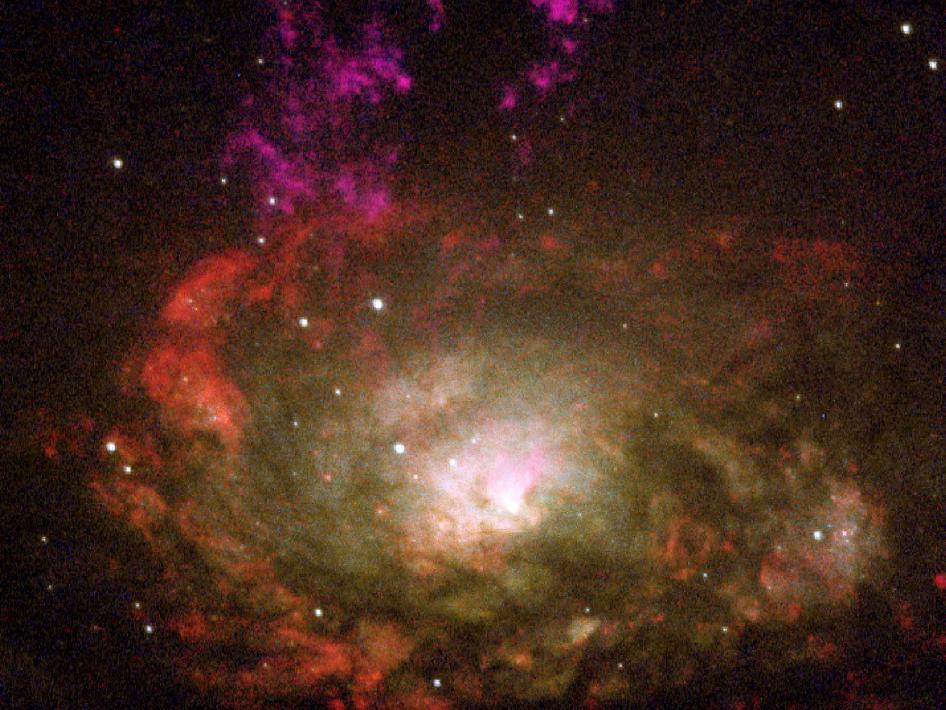
For many years scientists have known
that our sun gives off powerful
explosions, known as flares, that
contain millions of times more energy
than atomic bombs.
But when astronomers compare flares from
the sun to flares on other stars, the
sun's flares lose. On April 25, 2008,
NASA's Swift satellite picked up a
record-setting flare from a star known
as EV Lacertae. This flare was thousands
of times more powerful than the greatest
observed solar flare. But because EV
Lacertae is much farther from Earth than
the sun, the flare did not appear as
bright as a solar flare. Still, it was
the brightest flare ever seen from a
star other than the sun.
What makes the flare particularly
interesting is the star. EV Lacertae is
much smaller and dimmer than our sun. In
other words, a tiny, wimpy star is
capable of packing a very powerful
punch.
How can such a small star produce such a
powerful flare? The answer can be found
in EV Lacertae's youth. Whereas our sun
is a middle-aged star, EV Lacertae is a
toddler. The star is much younger than
our sun, and is still spinning rapidly.
The fast spin, together with its
churning interior, whips up gases to
produce a magnetic field that is much
more powerful than the sun's magnetic
field.
Image Credit: Casey Reed/NASA
Return to Index
|

This image of the Antennae galaxies is
the sharpest yet of this merging pair of
galaxies. During the course of the
collision, billions of stars will be
formed. The brightest and most compact
of these star birth regions are called
super star clusters.
The two spiral galaxies started to
interact a few hundred million years
ago, making the Antennae galaxies one of
the nearest and youngest examples of a
pair of colliding galaxies. Nearly half
of the faint objects in the Antennae
image are young clusters containing tens
of thousands of stars. The orange blobs
to the left and right of image center
are the two cores of the original
galaxies and consist mainly of old stars
criss-crossed by filaments of dust,
which appears brown in the image. The
two galaxies are dotted with brilliant
blue star-forming regions surrounded by
glowing hydrogen gas, appearing in the
image in pink.
The new image allows astronomers to
better distinguish between the stars and
super star clusters created in the
collision of two spiral galaxies. By age
dating the clusters in the image,
astronomers find that only about 10
percent of the newly formed super star
clusters in the Antennae will survive
beyond the first 10 million years. The
vast majority of the super star clusters
formed during this interaction will
disperse, with the individual stars
becoming part of the smooth background
of the galaxy. It is however believed
that about a hundred of the most massive
clusters will survive to form regular
globular clusters, similar to the
globular clusters found in our own Milky
Way galaxy. The Antennae galaxies take
their name from the long antenna-like
"arms" extending far out from the nuclei
of the two galaxies, best seen by
ground-based telescopes. These "tidal
tails" were formed during the initial
encounter of the galaxies some 200 to
300 million years ago. They give us a
preview of what may happen when our
Milky Way galaxy collides with the
neighboring Andromeda galaxy in several
billion years.
Image Credit: NASA, ESA, and the
Hubble Heritage Team (STScI/AURA)-ESA/Hubble
Collaboration
Return to Index
|
|
Aglow

Resembling a
swirling witch's cauldron of glowing vapors, the black
hole-powered core of the Circinus Galaxy lies 13 million
light-years away from our own.
This galaxy, designated a type 2 Seyfert, is a class of mostly
spiral galaxies that have compact centers and are believed to
contain massive black holes. Seyfert galaxies are themselves
part of a larger class of objects called Active Galactic Nuclei
or AGN. AGN have the ability to remove gas from the centers of
their galaxies by blowing it out into space at phenomenal
speeds.
In the center of the galaxy and within the inner starburst ring
is a V-shaped structure of gas. The structure appears
whitish-pink in this composite image, made up of four filters.
Two filters capture the narrow lines from atomic transitions in
oxygen and hydrogen; two wider filters detect green and
near-infrared light. In the narrow-band filters, the V-shaped
structure is very pronounced. This region, which is the
projection of a three-dimensional cone extending from the
nucleus to the galaxy's halo, contains gas that has been heated
by radiation emitted by the accreting black hole. A
"counter-cone," believed to be present, is obscured from view by
dust in the galaxy's disk. Ultraviolet radiation emerging from
the central source excites nearby gas causing it to glow. The
excited gas is beamed into the oppositely directed cones like
two giant searchlights.
Located near the plane of our own Milky Way Galaxy, the Circinus
galaxy is partially hidden by intervening dust along our line of
sight. As a result, the galaxy went unnoticed until about 25
years ago.
Image Credit: Credits: NASA, Andrew S. Wilson (University of
Maryland); Patrick L. Shopbell (Caltech); Chris Simpson (Subaru
Telescope); Thaisa Storchi-Bergmann and F. K. B. Barbosa (UFRGS,
Brazil); and Martin J. Ward (University of Leicester, U.K.)
Return to Index
|
|
Cosmic Zoom Lens

Cosmic Zoom Lens
A massive cluster of yellowish galaxies
is seemingly caught in a spider web of
eerily distorted background galaxies in
the left-hand image, taken with the
Advanced Camera for Surveys (ACS) aboard
NASA's Hubble Space Telescope.
The gravity of the cluster's trillion
stars acts as a cosmic "zoom lens,"
bending and magnifying the light of the
galaxies located far behind it, a
technique called gravitational lensing.
The faraway galaxies appear in the
Hubble image as arc-shaped objects
around the cluster, named Abell 1689.
The increased magnification allows
astronomers to study remote galaxies in
greater detail.
Image Credit: NASA; ESA; L. Bradley
(Johns Hopkins University); R. Bouwens
(University of California, Santa Cruz);
H. Ford (Johns Hopkins University); and
G. Illingworth (University of
California, Santa Cruz)
Return to Index
|
|
Return to Index
|
|













